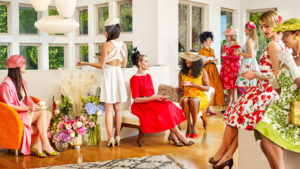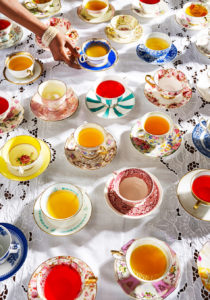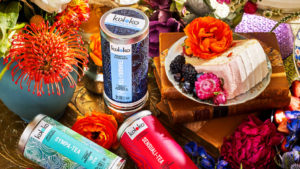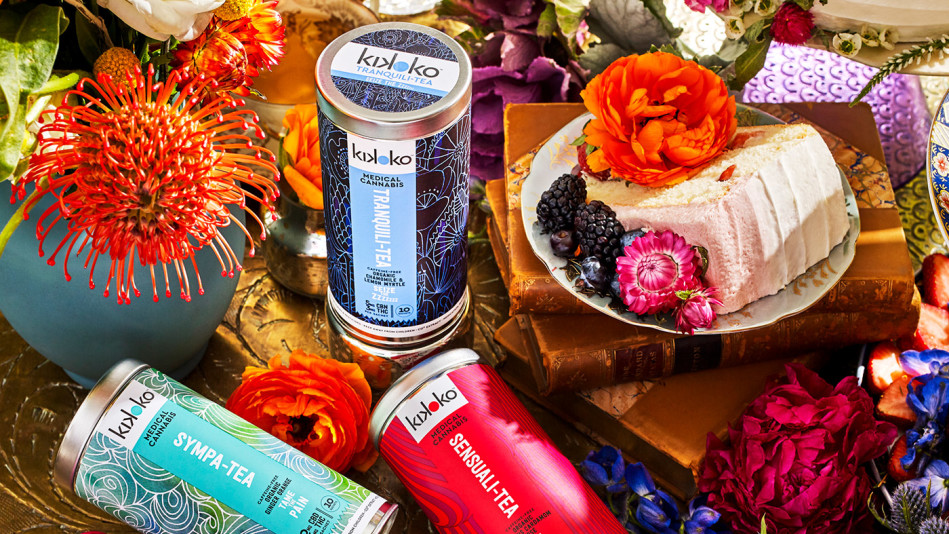We found this fantastic modern-times take on a tea party. Break out your fancy hats and fascinators.
Welcome to “High with Tea”: Why Moms Are Getting Mellow with Cannabis-Laced Tea
A pair of female marijuana mavericks has brewed up a new way to wind down.
By Molly Simms

Photo: Joyce Lee
I’m standing in the immaculate kitchen of a Spanish-style two-story in prim Palo Alto, California, next to a built-in beverage fridge. Tacked up on the wall is a family “School Year Schedule” full of alerts regarding band practice and errands. (Thursday: “Pick up Kristen’s dress from tailor!”) Amid the roar of small talk, women decked out in ladylike ensembles and formal hats adorned with feathers and crisp lace buzz around platters of tea sandwiches. Jennifer Chapin, a polished 54-year-old entrepreneur, is wearing a showstopper of a party frock, pearls, and fuchsia opera gloves. I’m in a Forever 21 denim jacket, and infinitely more familiar with cocktails than cocktail dresses, but we’re in conversational lockstep; she feels like an old friend I’ve reconnected with after decades apart. That’s probably because I’m super, super stoned.
I arrived at the tiled-roof home in an Uber since I knew I’d be spending the evening sipping hot tea infused with high-grade cannabis. That’s the featured offering from Kikoko (https://kikoko.com/), the tea brand launched in 2014 by Chapin and travel writer Amanda Jones. Local friends, and friends of friends, of Kikoko throw these “high tea” parties a couple of times a month, inviting women to get fuzzy at retro-themed soirees. Jones, a longtime costume collector with an excruciatingly lovely New Zealand accent and the warm elegance of an Eileen Fisher catalog, brings along dozens of vintage hats; wearing one during the party is pretty much mandatory. Each high tea includes a brief PowerPoint presentation on the history of and hysteria surrounding cannabis. Until California’s pot laws changed in January, limiting sales to licensed dispensaries and delivery services, the events were like 21st-century Tupperware parties, except instead of going home with a cupcake carrier, you got some cheerfully labeled narcotics. Now, although you can’t buy at the gatherings, you can still leave with enough of a buzz to make even C-SPAN funny.
Most of the guests tonight are newcomers to Kikoko or pot in general—Chapin estimates that 70 percent haven’t tried the tea before. As they walk in, a few faces are fixed in a “my friend talked me into this” rictus. Others look ready for the feds to kick down the door. (Several more have clearly been at the business end of a vape pen before, if their impish smiles and chunky hippie jewelry are any indication.) At most parties, the initial awkwardness would be drowned out by a waterfall of rosé. But no alcohol is served at Kikoko gatherings lest it amplify the tea’s effects and turn a meant-to-be-mellow night into a moms-gone-wild rager. The Kikoko devotees sand the edges off the mood, though, warming up newbies with small talk (“Have things been so crazy at work?”) and catch-up-on-the- kids chatter (“I heard she kicked ass at the swim meet!”).
Three 20-something “budtenders” in ’50s-style dresses act as on-the-fly educators. “How high would you like to get?” the model-pretty Riley asks me, with a gentle tilt of her pillbox hat, as we discuss my pot use. I typically smoke it two or three times a week (there goes my career as a Republican senator), so she recommends the Sensuali-Tea, saying, “It’s really good for conversation.” But since that’s the second strongest of Kikoko’s products, and I’m worried about forgetting how to operate my tape recorder, I go for a lower-dose option called Sympa-Tea.

Photo: Joyce Lee
“How about you pick a teacup that really speaks to you?” Riley suggests, gesturing at a dining room table laid with 70 colorful sets of antique china teacups and saucers. I choose an English rose pattern, which Riley fills with deep-pink tea from a hefty stainless steel urn. I’m pleasantly surprised. Expecting chamomile-scented bong water, I instead get a blend of ginger and orange, with only the faintest ghostlike aftertaste of marijuana.
The house’s owner is Tara, a former attorney wearing an elaborately constructed black hat as big as an industrial wok. She’s been smoking pot regularly since college, but looks like she could break into an impromptu decathlon at any moment. “I’m very into nutrition and fitness,” she says. “I don’t like alcohol. Everybody I know could easily drink a half bottle to a bottle of wine a night—but then they wake up feeling crappy and dehydrated.” Ellen, a blonde ob-gyn in a crimson dress, concurs: “We’re the demographic you associate with alcohol. I mean, try to buy a birthday card for a friend that doesn’t say ‘Let’s get drunk.'”
Unlike most of the women I speak with (who double- and triple-check that I won’t print even their first names in O), Tara isn’t shy about her fondness for herb, which makes her husband anxious. “He told me, ‘You know, if you have this party, you’re going to be shunned by polite society,'” she says. “I said, ‘Bring it on.’ My parents are weed smokers who never touch alcohol, and they look so young. My dad doesn’t have an ache or pain; my mom didn’t need any drugs for menopause. And everybody kept saying, ‘You have to meet the Kikoko ladies,’ so here we Are.”
Earlier today, on the back deck of Jones’s pristine modernist home with a view of Mount Diablo, Jones and Chapin ran down their company’s origin story over grain salads and seltzer. It began with watching a friend endure ovarian cancer. “She was using cannabis to medicate, and it was helping with sleep and pain and nausea and appetite,” said Chapin, a former tennis coach with a tomboy vibe and a business woman’s savvy. “The problem was, she was getting way too high; she was crawling to the bathroom on her hands and knees. But she came from the medical industry and saw the opportunities, so she encouraged me to start a company.” Chapin enlisted longtime friend Jones; their pals were more than supportive. “Everyone was like, ‘Now that we’re in our 50s, people are medicating with this, that, and the other pill. If you could come up with an alternative to pharmaceuticals, in tea form, we’d love it.'”
The partners’ goal? To provide a low-dose product that would serve as an easy entry point for the uninitiated. Edibles on the market often contain ten milligrams per serving of THC, the psychoactive compound in pot that makes you feel high. Kikoko teas contain between three and ten milligrams. “People told us, ‘With those low doses, you’ll be laughed out of dispensaries,'” Jones said. “But we couldn’t function on ten milligrams back then. I mean, it was fun when we’d lie around laughing, but…”
Chapin and Jones self-funded their baby with $80,000 its first year, banking on the fact that Americans are increasingly seeing pot as a panacea rather than a prescription for reefer madness. “It’s been used for thousands of years as a medicine,” Jones pointed out. “Plus, in states where medical cannabis is legalized, the number of opioid deaths has dropped by around 25 percent. It seems like a logical and much-healthier alternative.
“Customer-wise,” she continued, we thought we’d the focus on people like us, since women in their 40s, 50s, and 60s weren’t well addressed in the marketplace.”She wasn’t since kidding: A scan of dispensary shelves confirms pot’s dude-centric culture—think strains called Super Skunk, Skywalker, or the inscrutable Where’s My Bike. And the world of weed seems almost intentionally buck-wild, as if every consumer aims to get high enough to blank on their own last name. T-shirts from pot producer Phat Panda urge you to melt yo face!, while the logo for Voodoo Sours Medicated Candy is a drooling zombie with pinwheel eyes.
In that dank and druggy context, Kikoko was an outlier. “But now the people who refused to take us seriously are coming back wanting to invest. I have to say, I feel a little bit smug about that.” She and Chapin leaned in for a fist bump.
Kikoko (the name, a combo of a Hawaiian syllable and a Samoan word, doesn’t have an especially deep meaning—Chapin and Jones just liked the way it sounded) packages its wares in Marimekko-esque cans. The blends have pun-drenched monikers; each label explains its tea’s raison d’être in jokey text-to-your-sister prose. Sensuali-Tea “intensifies the big O” and helps you “find your tea spot,” while Sympa-Tea dials down pain and creates an effect that “feels like you just had an awesome massage.” Positivi-Tea, the option with the highest THC level, is geared toward a more social, hysterical-laughter-filled experience (though, as the can reassures, “You won’t get crazy high”). By this spring, Jones says, Kikoko products—with prices ranging from $40 to $60 for a ten-sachet can—will be available in more than 30 storefront dispensaries in California and, depending on local legislation, may be dropped off at customers’ homes by one of 20 online delivery services in the state.
Conceived in Silicon Valley, the brand is in sync with the white-collar impulses toward “disruption,” innovation, and affluence that fueled the tech boom. Kikoko’s biodegradable plant-starch-derived tea bags are filled with organic whole-leaf tea and pesticide-free herbs and flowers. A dry cannabis compound invented in a development lab hired by Kikoko is then mixed in. Add six to eight ounces of hot water, wait about an hour, and voilà—your mental state is hovering between half a Valium and the munchies scene from Nine to Five.
Whether you’re a two-decade High Times subscriber or a Nancy Reagan superfan, you can’t deny that weed is in vogue right now. It wasn’t always so. The anti-drug media campaigns of the 1930s were spectacularly effective; their fear-mongering influenced public policy for decades to come. In 1970, marijuana was classified as a Schedule 1 narcotic, vilified on the level of heroin; today thousands of people—disproportionately people of color—sit in prison for pot offenses. (Between 2001 and 2010, 8.2 million marijuana arrests occurred—88 percent for mere possession.) In January, Attorney General Jeff Sessions announced that federal prosecutors would be allowed to pursue marijuana cases even in states where weed is A-OK. When that news broke, the stock price of Scotts Miracle-Gro, maker of fertilizers beloved by pot producers, dropped 5.2 percent.
But at press time, nine states and Washington, D.C., had full-blown legalized weed, while 20 more had made it accessible with a prescription. Back in 1969, only 12 percent of Americans surveyed were in favor of legalization; last year 61 percent gave it a thumbs-up. Which means women just like you are increasingly likely to skip the Bordeaux and take hits of Bubba Kush Instead.
Debra Borchardt, a financial journalist who covers the cannabis business on her website Green Market Report, views all this ganja goodwill as a logical evolution. “A lot of American women probably never imagined they’d try cannabis,” she says. “Still, women are generally caregivers—that sounds stereotypical, but it’s true. And more and more caregivers are seeing this product helping children with seizures, veterans with PTSD, adults with cancer and Parkinson’s. It just grabs you.”
As a physician who specializes in preventive medicine, Jessica Knox, MD, works cannabis into patients’ treatment regimens. “It can alleviate chronic pain, be it menstrual or endometriosis related,” she says. “It helps with anxiety, insomnia. For cancer patients, it reduces nausea, stimulates appetite, and boosts mood. Some studies have shown that cannabis itself actually has anticancer properties. But most of that evidence comes from outside the country. Because of our laws, not a lot of research into cannabis’s benefits is conducted in the U.S.

Photo: Joyce Lee
“Marijuana is overwhelmingly safe,” says Knox. “SSRIs can have a lot of side effects, and opioids clearly are very problematic. Even some of the more benign-seeming over-the-counter medications can have long-term health effects on our stomach, our liver, our esophagus. And we’ve used those carte blanche. With cannabis, overuse means someone doesn’t feel well or might be stuck on the couch for a few hours, but people don’t fatally overdose. There’s been a lot of very effective propaganda against this plant, so it may take a big mind shift for some people to be open to it. I believe it should be a first-line medication for many conditions—it should be where we start.”
Aside from its potential health benefits, weed can also be, you know, a frickin’ good time. “Cannabis is medicine with a dash of fun,” says Jones. “We’re trying to give women of all ages permission to try something new.”
Two hours into the party, I’m chatting with Ellen the ob-gyn. “Every five years, I’ll take a puff of someone’s joint, and I get mute and wanna go home,” she says. “But the next time I want a glass of wine, I’m going to try a cup of this tea instead.”
As we talk, women are drifting toward the front door and returning their borrowed fascinators. An hour ago, Chapin asked how I was doing. “I’m not feeling anything. Maybe my tolerance is too high?” I said, making like Cheech’s troublemaking sister. In response, the budtender poured me a cup of Sensuali-Tea, and I downed the hibiscus-scented liquid. Now I could eat a 30-gallon Hefty bag of tortilla chips. I want to tilt that silver tray of crustless sandwiches like the Titanic and let all the smoked-salmon passengers tumble into my mouth. Ellen has massive, Betty Boop eyes—were they always this Boopian?—and they are twin planets I’d happily crash-land on and never be rescued from. “I have three little boys at home, so I should get going,” she says, glancing at her phone, her hat’s feather wagging along with each word. “They’re going to wonder where Mommy is.”
